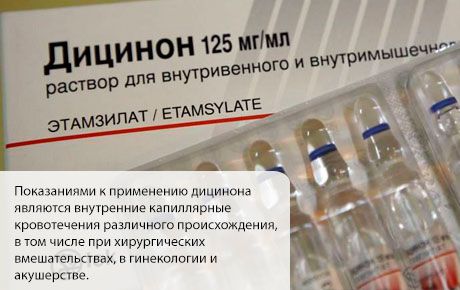Medical expert of the article
New publications
Preparations
Dicinone in pregnancy
Last reviewed: 08.07.2025

All iLive content is medically reviewed or fact checked to ensure as much factual accuracy as possible.
We have strict sourcing guidelines and only link to reputable media sites, academic research institutions and, whenever possible, medically peer reviewed studies. Note that the numbers in parentheses ([1], [2], etc.) are clickable links to these studies.
If you feel that any of our content is inaccurate, out-of-date, or otherwise questionable, please select it and press Ctrl + Enter.

In drug treatment aimed at stopping bleeding, hemostatic drugs are used - tranexam or dicinone during pregnancy.
During pregnancy, women may face such a serious problem as bleeding. It occurs for various reasons. In the first three months of gestation, when bloody discharge appears, there is a suspicion of a threat of miscarriage, ectopic pregnancy and antenatal death of the fetus. And the onset of bleeding in the second half of pregnancy may be a signal of premature placental abruption (with possible formation of a retroplacental hematoma), low location or placenta previa, as well as a sign of exacerbated diseases of the cervix or body of the uterus.
In any case, you should immediately contact a gynecologist who will determine the specific cause of the pathology and prescribe treatment.
The use of Dicynone in the early stages of pregnancy, as well as in the second and third trimesters, is permissible only as prescribed by a doctor.
 [ 1 ]
[ 1 ]
Dosage of Dicynone during pregnancy
This medicine is available in the form of tablets (250 mg) and injection solution (in ampoules of 2 ml/250 mg).
The therapeutically justified daily dosage of dicinone during pregnancy is 10-20 mg of the drug per kilogram of weight. As a rule, the doctor prescribes taking dicinone tablets during pregnancy one piece (250 mg) - 3-4 times during the day. The maximum effect when taken orally is achieved three hours after the tablet enters the stomach and lasts for five hours. The duration of taking the tablets is determined by the doctor depending on the intensity of bloody discharge.

Parenteral use of dicinone - in the form of intradermal or intravenous injections - causes a hemostatic effect much faster: after a quarter of an hour, and the maximum effect is noted on average after an hour and a half (with intramuscular administration - a little longer). Therefore, intravenous injections of dicinone during pregnancy are more appropriate with fairly intense bloody discharge.
 [ 2 ]
[ 2 ]
Instructions for dicinone during pregnancy
The instructions for Dicynone state that "use during pregnancy is possible only in cases where the potential benefit of therapy for the mother outweighs the possible risk to the fetus. If it is necessary to prescribe the drug during lactation, breastfeeding should be discontinued." What does this mean? In pharmacology, such a formulation appears in the instructions for those drugs that were not developed without studies of their embryotoxic and teratogenic effects. That is, the safety of such drugs when penetrating the placental barrier has not been established.
According to the instructions, the drug Dicynone (trade name - Etamzilat) promotes the production of platelets by the red bone marrow, and also accelerates their entry into the blood plasma. In addition, under the influence of this hemostatic (hemostatic) agent, the intensity of the processes of thromboplastin formation increases, which ensures blood clotting in damaged areas of the endothelium lining the inner surface of the capillaries. At the same time, the level of platelets in the blood remains within the normal range, so with a low level of platelets, it makes no sense to use Dicynone.
During pregnancy, or rather, during bleeding that occurs during pregnancy, Dicynone acts as a stimulator of the adhesive-aggregation activity of platelets (i.e. their “sticking” to damaged areas of the blood vessel wall and the formation of a platelet plug). It is due to this (and not due to increased blood coagulation) that bleeding stops.
Indications for the use of Dicynone are internal capillary bleeding of various origins, including during surgical interventions, in gynecology and obstetrics. Among the emergency cases of using this drug are increased bleeding (hemorrhagic diathesis), pulmonary and intestinal bleeding.
Among its contraindications are: hypersensitivity to the substances included in its composition; acute form of such a hereditary disease as porphyria; impaired blood flow in the form of venous thrombosis, as well as blockage of a blood vessel by a thrombus (thromboembolism).
Tranexam or Dicynone during pregnancy: which is better?
Like dicinone, during pregnancy doctors can prescribe another hemostatic drug - tranexam (synonyms - urugol, tranex). This drug penetrates the placental barrier and therefore is used during pregnancy only as prescribed by a doctor in cases where the benefit to the pregnant woman outweighs the potential risk to the fetus.
In addition, when prescribing tranescam, its contraindications should be taken into account: thrombosis or the threat of its development, deep vein thrombophlebitis, thromboembolic syndrome, impaired color vision, renal failure.
Tranexam is used during pregnancy in the same cases as dicinone. But its pharmacodynamics are different. Tranexam acts as a hemostatic agent with an increased level of fibrinolysin (plasmin) - a blood component that prevents its clotting. This drug slows down the activation of a special proenzyme plasminogen and its conversion to fibrinolysin. That is, it affects hemostasis, increasing intravascular blood clotting.
Tranexam in tablets (250 mg) doctors prescribe one tablet 3-4 times a day. In case of bleeding in the first trimester of pregnancy - to stop its spontaneous interruption - the daily dose of the drug is no more than 1000 mg (4 tablets), at later stages - 1000-2000 mg per day. The injection method of administration involves intravenous administration of tranexam in the form of a solution (in ampoules of 5 ml). The dosage is determined depending on the volume of blood loss and body weight: 10-15 mg per kilogram.
If you take tranexam or dicynone during pregnancy, undesirable side effects may occur. Thus, taking dicynone can cause headache, dizziness, flushing of the face, nausea, heartburn, pain in the stomach, decreased blood pressure, numbness (paresthesia) of the legs.
And the possible side effects of tranexamic acid are dizziness, weakness, drowsiness, skin rash and itching, vomiting, nausea, diarrhea, heartburn, loss of appetite, impaired color perception, as well as tachycardia and chest pain.
Price of dicynone during pregnancy
Today, depending on the manufacturer and the region of Ukraine, the price of Dicynone during pregnancy varies: Dicynone tablets (250 mg, 100 pieces package) - within 95-135 UAH; Dicynone in the form of an injection solution (250 mg, 2 ml ampoules, 50 pieces package) - from 90 to 145 UAH per package. The average cost of one ampoule (if a particular pharmacy sells drugs in ampoules individually) is about 2 UAH.
Prices for tranexam in tablets (package of 30 pcs.) produced in the Russian Federation are in the range of 178-225 UAH; the cost of a package of tranex (30 capsules of 250 mg) by Malesci is 132-168 UAH. Ugurol (tranexam) by Rottafarm in ampoules of 5 ml (5 ampoules in a package) costs approximately 220-240 UAH. And the price of tranexam for parenteral use is 768-790 UAH for 10 ampoules of 5 ml.
Reviews of Dicynone during pregnancy
Hemostatic drugs, in particular tranexam or dicinone during pregnancy, are used in cases where it is necessary to stop bleeding despite their side effects. The use of these drugs, as evidenced by examples of clinical practice and medical reviews of dicinone during pregnancy, is entirely justified, as it helps to stop blood loss and in many situations avoid miscarriage in the early stages of bearing a child. At the same time, the impact on the indicators of the hemostasis system, that is, the system that ensures the balance of coagulation and coagulation of blood while maintaining its liquid state, is minimal.
And the reviews of Dicynone during pregnancy from those patients who themselves had to take this medicine are different. For some, it helped to maintain the pregnancy, and for others, despite the efforts of doctors, it was not possible to do so...
It should be remembered that Dicynone during pregnancy - like any other pharmaceutical drug in these circumstances - must be prescribed by a doctor! And the doctor must be 100% sure that the potential benefit of the drug prescribed to the expectant mother is much higher than the possible risk to the life and health of her future child.
Attention!
To simplify the perception of information, this instruction for use of the drug "Dicinone in pregnancy" translated and presented in a special form on the basis of the official instructions for medical use of the drug. Before use read the annotation that came directly to medicines.
Description provided for informational purposes and is not a guide to self-healing. The need for this drug, the purpose of the treatment regimen, methods and dose of the drug is determined solely by the attending physician. Self-medication is dangerous for your health.

